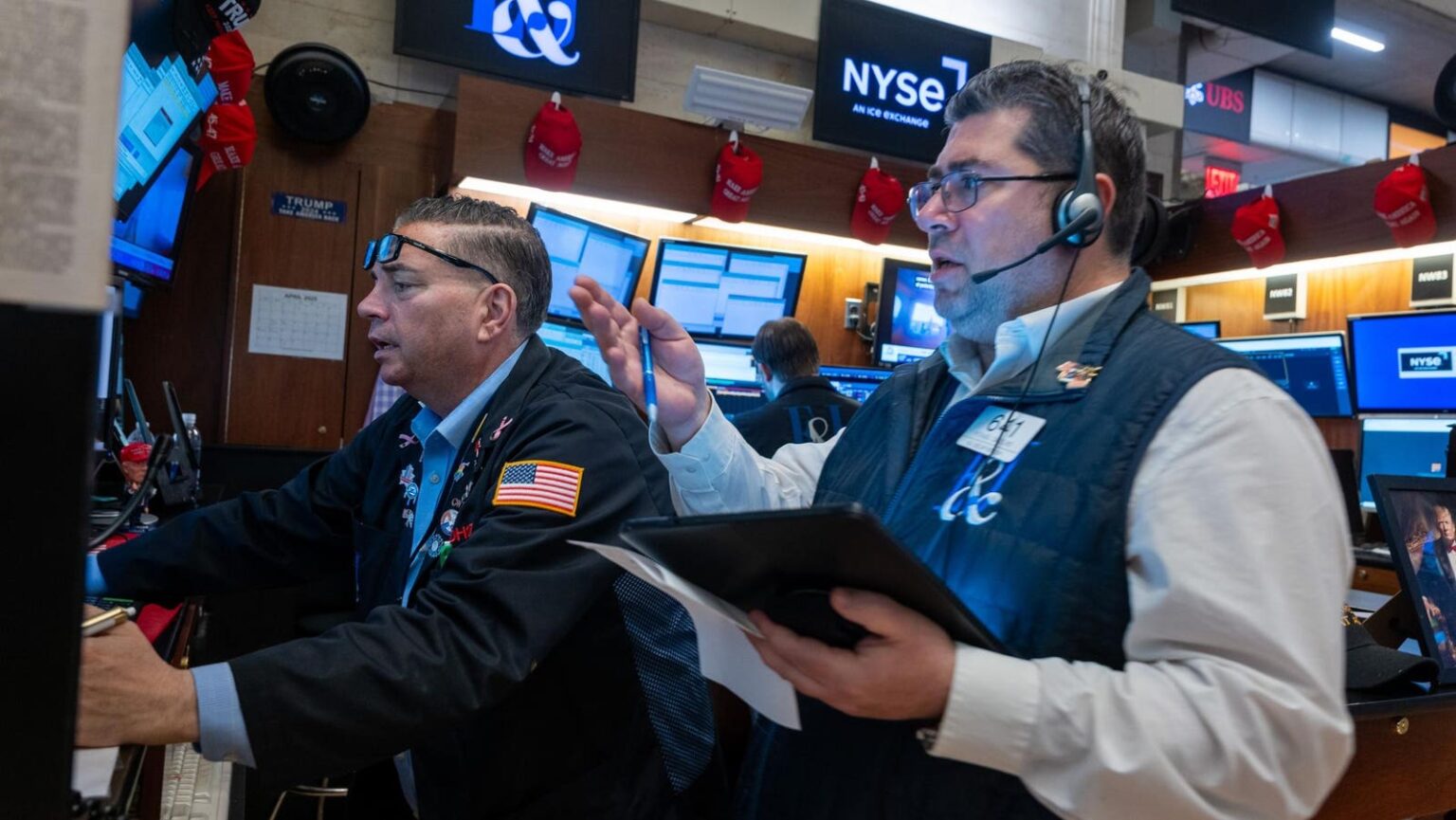Topline
Investors did not get the rebound from Thursday’s historic losses they may have hoped for, as stocks again slid considerably as the market digests President Donald Trump’s tariffs while China, the world’s second-largest economy, slapped a 34% retaliatory tariff on American imports.
A traders work on the floor of the New York Stock Exchange on Thursday.
Getty ImagesKey Facts
Thursday was the sharpest daily decline since 2020 for each of the three major U.S. indexes – the Dow Jones Industrial Average (-4%, or 1,680 points, Thursday), the S&P 500 (-5%) and the tech-heavy Nasdaq (-6%) – and things got even worse in the market Friday.
The Dow fell 5.5%, or about 2,200 points, by early afternoon, extending its two-day loss to about 4,000 points, while the S&P and Nasdaq fell about 6% apiece Friday, sending the S&P’s and Nasdaq’s declines since Trump’s Wednesday tariff announcement to 11%.
All three indexes are down at least 10% from their record levels set a few months ago, residing in correction territory, and the Nasdaq fell into a bear market as it traded more than 20% below its December all-time high, entering its first bear market since 2022.
Stocks slid to their lowest levels in several months, as the Dow and S&P hit their lowest intraday prices since May and the Nasdaq touched its cheapest level since April 2024.
The S&P’s 9% loss since last Friday makes this stocks’ worst week since March 2020 and the fifth-worst week of the last 20 years, trailing only losses sustained in October 2008 and early 2020.
The selloff wiped out more than $4.9 trillion of market capitalization among stocks listed on the S&P, according to FactSet data, led by Apple, Nvidia and Tesla’s more than $1 trillion combined loss.
What Stocks Have Fallen The Most From Tariffs?
In addition to the impact of continued negative sentiment from the 10% or greater tariffs on most imports unveiled Wednesday, investors also reacted sourly to the China-led trade countermeasures and Trump’s lack of capitulation, as the president posted Friday to social media his “POLICIES WILL NEVER CHANGE.” Particularly hard hit were shares of American firms which rely on China for a significant portion of their revenues, as shares of iPhone maker Apple, coffee chain Starbucks and Elon Musk’s automaker Tesla each declined at least 7%. Since Wednesday, the biggest percentage stock losers among American companies valued at $100 billion or greater are ConocoPhillips, Citigroup, Boeing, Bank of America, Starbucks, GE Aerospace, Qualcomm, Morgan Stanley, Goldman Sachs, Advanced Micro Devices, Wells Fargo and Apple. Shares of each American titan lost 15% or more during the two-day span.
Fed Says No Emergency Interest Rate Cuts Yet
Trump called on Federal Reserve Chairman Jerome Powell to immediately lower interest rates, but Powell showed no inclination to do so in a Friday speech, saying it is “too soon” to determine the next monetary policy action. Powell did issue a stark warning on the economic fallout of tariffs, saying they will cause “higher inflation and slower growth.”
Surprising Fact
Thursday and Friday mark one of the few times in modern history the S&P declined 4.8% or more on consecutive days. Over the last two decades, that has only happened three other times: Nov. 5-6 and Nov. 19-20, 2008, at the height of the financial crisis, and March 11-12, 2020, at the beginning of the COVID-19 pandemic.
Big Number
60%. Those are the odds the global economy enters a recession in 2025, JPMorgan economists wrote in a Thursday note to clients.
Contra
The Friday losses came despite a better-than-expected March jobs report released before market open, revealing the U.S. added 228,000 jobs last month, far better than consensus economist forecasts of 140,000. It’s a “reminder that economic fundamentals were robust heading into the tariff storm,” EY-Parthenon economist Lydia Boussour wrote in emailed comments, adding “the downside risks to the labor market…have escalated significantly in recent days.”
Oil Prices Crater To 4-Year Low
Crude oil prices sank Friday as recession concerns translated into fears about weaker consumers globally. International benchmark Brent crude prices declined 7% to $65 per barrel, the lowest level since April 2021.
Tangent
The CBOE Volatility Index (VIX), commonly referred to as Wall Street’s fear gauge, is on track to close Friday at its highest level since October 2020, spiking by almost 80% since Wednesday.
Forbes Survey Finds Wall Street Not Happy With Trump
A Forbes poll of 50 influential individuals on Wall Street, including billionaire investors, big-time money managers and economists, found two-thirds of respondents don’t support Trump’s economic policies during his second term, with more than 70% noting his economic policy rollout has not been effective.
Chief Critic
“This is the biggest policy mistake in 95 years,” Jeremy Siegel, a professor at University of Pennsylvania’s Wharton School of Business, Trump’s alma mater, told CNBC on Friday.
Further Reading
Read the full article here


